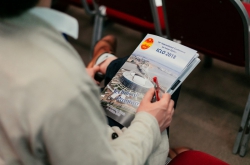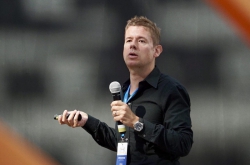CROPS 2017 has become ITMO’s first conference in photonics and optics to involve representatives of as much as five Chinese universities. What’s more, ITMO University and Changchun University of Science and Technology are partner universities. As part of their collaboration, the Chinese university sends its PhD and Master’s students to ITMO university; the Chinese are also interested in inviting ITMO’s staff to train their students. Students of both universities can participate in short-term exchange programs, as well. Last month, a group from ITMO went to Changchun University of Science and Technology; the visit coincided with the 1st CUST and ITMO International and Academic Forum that brought together more than a hundred specialists. PhD students and staff from Federal Almazov North-West Medical Research Center also participated in the event as part of ITMO’s delegation.
“We’ve been thinking about conducting our event since summer. The initial idea came from students who are part of the university’s optical student chapter. We spent some time deciding on the event’s format, choosing between a forum and a winter school. Gradually, it became a symposium that brought together 76 people, including 34 foreigners. The event turned out to be very comprehensive, as it included tours of ITMO’s laboratories, as well as lectures and workshops on such subjects as terahertz photonics, carbon nanotubes, modeling of processes of interaction between radiation and biological objects, quantum physics - and other activities,” says Anna Vozianova, Research Associate of the Department of Photonics and Optical Information Technologies.
 Anna Vozianova and Mikhail Khodzitsky
Anna Vozianova and Mikhail Khodzitsky
The symposium’s guests visited ITMO’s laboratories (SCAMT Laboratory, Terahertz Biomedicine Laboratory) and divisions that focus on promoting R&D activities (FabLab, OLIMP Laboratory, the Museum of Optics). What is more, special tours were organized to the Tydex company that produces optical components and devices for science and industry and to Federal Almazov North-West Medical Research Center. Meetings with the representatives of industry, such as I-Ray (China) and Fibertoll (Russia), and the working session of the heads of student divisions of international photonics and optics societies (SPIE, OSA, IEEE) also took place as part of the symposium. Both Russian and Chinese specialists took great interest in the workshop by Konstantin Grebenuk from Saratov State University who presented his proprietary technology for studying Chinese.
“We’ve been collaborating with ITMO University for several years already, working at the intersection of biophysics and medicine, and are now strengthening relations with our Chinese partners. I participated in the trip to Changchun University of Science and Technology last month, it was great to meet our Chinese colleagues, as we’ve begun to closely collaborate with them. As part of the symposium, we organized a tour of the Preclinical Translational Research Centre - a new subdivision of our facility that focuses on a science-based approach and has all the necessary equipment for conducting research,” explains Yulia Kononova from the Federal Almazov North-West Medical Research Center.

As part of the symposium, a new agreement on short-term exchange programs was discussed, according to which a new group of students from China will be coming to the university next June. The group will consist of two PhD students and four research associates. According to Mikhail Khodzitsky, Associate Professor at the Department of Photonics and Optical Information Technologies, this trip will involve a short-term module on terahertz photonics, as the Chinese representatives are very interested in terahertz technologies and their use in biomedicine.
“Our university has been collaborating with ITMO for a very long time, so, when we learned of the upcoming conference in Russia, I decided to become part of the delegation at once. Here in Russia, I got to listen to many lectures on topics I am interested in. For instance, the lecture by professor Igor Meglinski on an online platform for the purposes of biomedical optics and biophotonics based on the Monte-Carlo method really stuck in my memory,” shares Li Bo, PhD student from the Changchun University of Science and Technology.
 Symposium participants get certificates.
Symposium participants get certificates.
The Biomedical Photonics Research and Technology Center of the Orel State University also took part in organizing the symposium. The center’s team conducted the workshop «Experimental measurements of the blood microcirculation system» where they demonstrated the basic aspects of applying laser Doppler flowmetry in medicine. The workshop was conducted using an experimental unit developed by the center’s staff as part of a strategic project of Orel State University.
“Apart from presenting our reports, our team of five people also organized a workshop. We work on assessing the condition of microcirculation by means of optics and photonics and using it in medical practice. My report was dedicated to the development of such technologies. At the workshop, we demonstrated some experiments so as to show why we need these methods - meaning the report expanded on the different aspects of our reports. What was great was that during the symposium we got to know some cultural facts about living in China. For instance, about their work at the universities, how it is different from what we have in Russia. This was the first time we cooperated with ITMO University as co-organizers, previously, we’d only come to the conferences the university conducts several times a year,” says Igor Kozlov, PhD student from the Biomedical Photonics research and technology center of Orel State University.

As part of the symposium, the participants attended several lectures. For instance, the symposium was opened with a lecture by Dr. Anna Baldycheva, professor at the University of Exeter, UK, which was dedicated to carbon nanomaterials and their application. On the final day of the conference, professor Igor Meglinski from the University of Oulu, Finland conducted a series of workshops dedicated to using the Monte-Carlo method for computing simulation of tasks of biomedical optics and biophotonics.
“Truth be told, I had many reasons for participating in the symposium. I’m a student of Mikhail Khodzitsky, and I actively participate in our laboratory’s life, so I gladly agreed to help with all of the organizational matters of the conference. What is more, I am responsible for one of the terahertz units - the all-purpose impulse terahertz spectrometer that was used for the workshop on experimental terahertz photonics. Three people took part in the conducting the workshop: Mikhail Khodzitsky explained the device’s design, I gave further details and helped with measurements and Svyatoslav Gusev, president of ITMO’s optical student charter helped students with the signals’ postprocessing,” comments Petr Demchenko, Bachelor’s student at the Department of Photonics and Optical Information Technologies.
 Svyatoslav Gusev
Svyatoslav Gusev
The Chinese-Russian Optics & Photonics Symposium for Young Scientists CROPS 17 was organized by the ITMO University’s optical student chapter OSC and Terahertz Biomedicine laboratory with support from Federal Almazov North-West Medical Research Center, ITMO University’s International Laboratory “Radiation Medicine”, and the Tydex company.
“I’d like to express our gratitude to members and officers of our optical student charter ITMO OSC, who were responsible for organizing the conference, as well as its curators Anna Vozianova and Mikhail Khodzitsky. The symposium’s conduct was supported by the Optical Society OSA, namely our charter won a grant as part of a Special event grant program. Apart from that, international optical charters from Saint Petersburg Electrotechnical University and Crimean Federal University, being the event’s co-organizers, invited lecturers from Great Britain and Finland as part of the SPIE Visiting Lecturer program. On Friday, representatives of the Changchun University of Science and Technology, Nankai University, University of Science and Technology Beijing, Crimean Federal University, Orel State University and, of course, ITMO University presented their charters. It was great to see that the recently founded charters follow our example and aim to develop and collaborate with each other,” concludes ITMO’s PhD student Svyatoslav Gusev, president of the University’s optical student charter.





